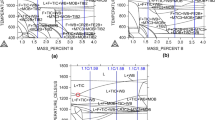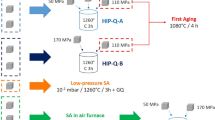Abstract
The addition of small amounts (1%) of nickel were sufficient to activate liquid-phase sintering and improve phase interface adhesion and the mechanical properties of molybdenum-copper pseudoalloys with a complex bimodal pore structure. The pseudoalloys retained high porosity (up to 75%) after sintering. This was achieved by lowering the microporosity in the biporous materials, thus decreasing the total amount of shrinkage which occurred during the sintering process.
Similar content being viewed by others
References
A. G. Kostornov and V. P. Semenets, “Pore structure and hydrodynamic properties of permeable molybdenum-copper composites,”Poroshk. Metall., No. 2, 26–31 (1990).
A. G. Kostornov and V. P. Semenets, “Formation of interparticle contacts in the sintering of molybdenum-copper composites,”Poroshk. Metall., No. 3, 25–30 (1990).
A. G. Kostornov and V. P. Semenets, “Pysico-mechanical properties of porous molybdenum-copper composites,”Poroshk. Metall., No. 4, 59–62 (1990).
L. I. Chernyshev, “Formation of the pore structure of biporous materials in relation to the volume changes during sintering,”Poroshk. Metall., Nos. 9–10, 97–103 (1999).
V. L. Yupko, V. V. Garbuz, and N. I. Kryuchkova, “Wetting of molybdenum by Cu-O melts,”Poroshk. Metall., No. 10, 72–78 (1991).
V. N. Eremenko, Yu. V. Haidich, and I. A. Lavrinenko,Sintering in the Presence of a Liquid Metal Phase [in Russian], Nauk, Dumka, Kiev (1969).
G. V. Levchenko, “Metal-ceramic contacts with elevated disconnection abilities,”Diss. Kand. Tech. Nauk, Kiev (1964).
R. V. Minakova, N. D. Lesnik, and A. A. Flis, “Effect of additions on the adhesional properties and formation of interphase boundaries in systems of tungsten and molybdenum with copper, silver, and their alloys,”Adgez. Rasplavov Payka Mater., No. 12, 54–57 (1994).
V. V. Skorokhod, S. M. Solonin, and L. I. Chernyshev, “Sintering mechanism of highly porous materials in the presence of a volatile pore former,”Proshk. Metall., No. 11, 31–36 (1974).
M. Yu. Bal’shin,Scientific Principles of the Powder Metallurgy of Fibers [in Russian], Metallurgiya, Moscow (1972).
V. V. Skorokhod and S. M. Solonin,Physico-Metallurgical Principles of Powder Sintering [in Russian], Metallurgiya, Moscow (1984).
V. V. Skorokhod, S. M. Solonin, and L. I. Chernyshev, “Highly porous tungsten-copper materials obtained by liquid-phase sintering,”Poroshk. Metall., No. 2, 17–21 (1978).
Yu. V. Haidich, V. M. Perevertailo, I. A. Lavrenko, et al.,Surface Properties of Melts and Solid Bodies and their Applications in Materials Science [in Russian], Nauka Dumka, Kiev (1991).
V. I. Trefilov, Yu. V. Mil’man, and S. A. Firstov,Physical Principles of the Strength of Refractory Metals [in Russian], Nauk, Dumka, Kiev (1975).
R. V. Minakova, V. D. Voitenko, P. A. Verkhovodov, et al., “Fractographic features of fractures of the alloy WC-Ni-Fe (90:7:3),”Poroshk. Metall., No. 2, 81–92 (1985).
I. N. Frantsevich, N. D. Lesnik, R. V. Minakova, et al., “Composite materials for high-current contacts and electrodes,” in:Proceedings of the Powder Metallurgy Conference, Warsaw (1972), Part 2, pp. 457–472.
V. V. Skorokhod,Rheological Principles of Sintering Theory [in Russian], Nauk, Dumka, Kiev (1972).
L. D. Landau and E. M. Lifshits,Electrodynamics of Continuous Media, GITTL, Moscow (1957).
I. K. Kikoin (ed.),Tables of Physical Values: Handbook [in Russian], Atomizdat, Moscow (1976).
L. I. Chernyshev, “Liquid-phase sintering of molybdenum-copper alloys with a biporous structure,”Poroshk. Metall., No. 2, 36–39 (1987).
Additional information
Institute for Problems of Materials Science, Ukraine National Academy of Sciences, Kiev. Translated from Poroshkovaya Metallurgiya. Nos. 11–12(410), pp. 53–61, November–December, 1999.
Rights and permissions
About this article
Cite this article
Chernyshev, L.I. Effect of nickel additions on the sintering and properties of biporous molybdenum-copper pseudoalloys. Powder Metall Met Ceram 38, 579–585 (1999). https://doi.org/10.1007/BF02676190
Received:
Issue Date:
DOI: https://doi.org/10.1007/BF02676190




